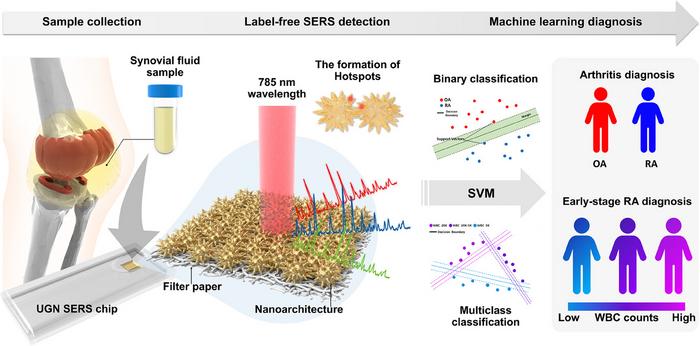In a groundbreaking advancement for medical diagnostics, Dr. Ho Sang Jung and his research team at the Korea Institute of Materials Science (KIMS) have developed a rapid diagnostic technology that can differentiate between osteoarthritis and rheumatoid arthritis within a mere 10 minutes. This innovative approach utilizes synovial fluid—an essential lubricant found in the joints—shifting the paradigm of how these prevalent conditions are assessed and managed. The collaboration with Seoul St. Mary’s Hospital marks a significant achievement as Korea emerges in the forefront of arthritis diagnostics.
Numerous studies reveal that osteoarthritis impacts over 50% of the senior population aged 65 and older, with rheumatoid arthritis being a serious chronic illness affecting roughly 1 in 100 individuals throughout their lives. One of the fundamental challenges faced by healthcare professionals lies in the need for accurate differentiation between these two types of arthritis at early stages, given their distinct causes, symptoms, and treatment options. Traditional methods such as X-rays, MRIs, and blood tests are not only cumbersome but also entailed in high costs and varied accuracy.
Synovial fluid analysis presents a unique avenue for diagnosis. Dr. Jung’s team focused on the metabolic profiles, specifically the metabolites generated as byproducts of chemical processes within the body. By closely examining the nuances in the composition of these metabolites present in the synovial fluid, they created a diagnostic technology capable of swiftly identifying whether a patient has osteoarthritis or rheumatoid arthritis while also gauging the severity of the rheumatoid arthritis within the same timeframe.
At the heart of their methodology lies Surface-Enhanced Raman Scattering (SERS) technology. SERS functions through a remarkable amplification of molecular optical signals, enhancing the detection of trace amounts of molecules within synovial fluid. This powerful technology is combined with sophisticated artificial intelligence-based analysis algorithms, allowing for the detection of minute biochemical substances that distinguish between the two conditions. Through the use of an ingeniously designed sensor that embodies a sea urchin-like gold nanostructure resting on a moisture-absorbing paper surface, the researchers have ensured the method not only remains precise but also convenient for clinical settings.
Collaborating with Seoul St. Mary’s Hospital provided the research team with an invaluable real-world testing ground, wherein they conducted trials across 120 patients. The remarkable results revealed an accuracy exceeding 94% in diagnosing and distinguishing between osteoarthritis and rheumatoid arthritis. Furthermore, the technology demonstrated a staggering over 95% accuracy for assessing the severity of rheumatoid arthritis. These figures underscore both the efficacy and the potential this technological advancement holds for transforming arthritis diagnostics, significantly reducing the time and financial burden on healthcare systems.
Dr. Ho Sang Jung expressed his optimism regarding the commercialization potential of their developed technology. He emphasized its utility not only in the diagnostic realm but also as a vital tool for monitoring the treatment progress of individuals diagnosed with arthritis. In acknowledgment of future endeavors, he hinted at extending research efforts to encompass a wider array of diseases, ensuring the sustainability of innovation within the healthcare landscape.
This extensive research endeavor has been generously supported by the Bio & Medical Technology Development Program and the Global Young Researcher Program from the National Research Foundation of Korea. Additionally, the Materials and Components Technology Development Program under the Ministry of Trade, Industry and Energy further funded these cutting-edge investigations. The comprehensive findings of this research have been made available online as of March 30 and are slated for publication in the esteemed April 2025 issue of “Small,” a leading scientific journal recognized globally in the realm of nanomaterials.
Dr. Jung’s research, with its innovative approach to arthritis diagnosis, not only represents a significant milestone for the Korea Institute of Materials Science but also sets a noteworthy example for future research in similar disciplines. As the healthcare sector continues to explore rapid and efficient diagnostic tools, the intersection of biotechnology and healthcare shines a promising light on enhancing patient outcomes and streamlining health services.
As the world awaits the promising implementation of this diagnostic technology, it reinforces the vital need for collaboration across research institutions and medical facilities. The intersection of rapid diagnostics and artificial intelligence could very well define the future of patient care, creating avenues for more proactive approaches in managing chronic ailments. The implications are broad, potentially translating into better resource allocation within healthcare systems and, ultimately, elevating the standard of medical care available to patients suffering from these challenging conditions.
In conclusion, the advancements made by Dr. Jung and his team elucidate a paradigm shift in the diagnosis and treatment monitoring of arthritis. With continued support and collaboration, the potential to explore novel diagnostic methods remains vast, likely reshaping our understanding and management of various diseases well into the future.
Subject of Research: Rapid diagnosis and differentiation of osteoarthritis and rheumatoid arthritis using synovial fluid analysis.
Article Title: AI-Assisted Plasmonic Diagnostics Platform for Osteoarthritis and Rheumatoid Arthritis With Biomarker Quantification Using Mathematical Models.
News Publication Date: March 30, 2025.
Web References: N/A
References: N/A
Image Credits: Korea Institute of Materials Science (KIMS)
Keywords
Arthritis, Osteoarthritis, Rheumatoid Arthritis, Rapid Diagnostics, Synovial Fluid, Surface-Enhanced Raman Scattering, Artificial Intelligence, Healthcare Innovation, Korea Institute of Materials Science, Nanotechnology.




